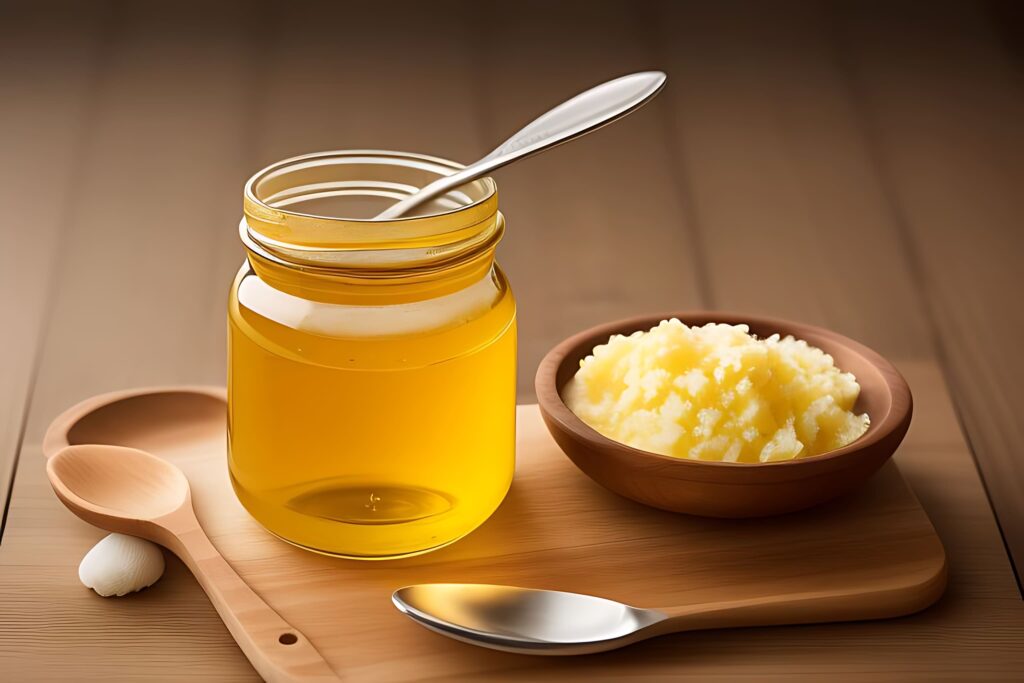
Ghee, a staple in many kitchens around the world, has been celebrated not only for its rich flavor but also for its numerous health benefits. Recently, a new type of ghee has been making waves—A2 milk ghee. But what exactly sets A2 milk ghee apart from traditional ghee? And which one should you choose for your dietary needs? Let’s dive into the differences between A2 milk ghee and traditional ghee to help you make an informed decision.
Understanding A2 Milk Ghee
A2 milk ghee is derived from the milk of cows that produce A2 beta-casein protein, such as indigenous Indian breeds like Gir, Sahiwal, and Tharparkar. This type of ghee is known for its purity, being free from the A1 beta-casein protein commonly found in milk from crossbred or non-native cows.
Key Characteristics of A2 Milk Ghee:
- Source: Made from A2 milk produced by indigenous cows.
- Protein Type: Contains only A2 beta-casein protein.
- Production Method: Often prepared using traditional methods, including the Bilona process, which involves curdling the milk, churning it into butter, and then heating the butter to obtain ghee.
- Health Benefits: Believed to be easier to digest and less likely to cause inflammation or digestive discomfort.
Understanding Traditional Ghee
Traditional ghee, often referred to as A1 ghee, is usually made from the milk of cows that produce both A1 and A2 beta-casein proteins. This includes milk from crossbred cows such as Holstein, Jersey, and others commonly found in large-scale dairy operations.
Key Characteristics of Traditional Ghee:
- Source: Made from milk that contains a mix of A1 and A2 beta-casein proteins.
- Protein Type: Contains both A1 and A2 proteins.
- Production Method: Typically produced on a larger scale, sometimes using more modern methods that may not follow traditional practices.
- Health Benefits: Provides similar benefits as ghee but may cause digestive issues for those sensitive to A1 protein.
Key Differences Between A2 Milk Ghee and Traditional Ghee
- Protein Composition
- A2 Milk Ghee: Contains only A2 beta-casein, which is believed to be easier on the digestive system and less likely to cause inflammation.
- Traditional Ghee: Contains a mix of A1 and A2 beta-caseins. A1 beta-casein is associated with potential digestive discomfort in some individuals.
- Digestibility
- A2 Milk Ghee: Often reported to be gentler on the stomach and easier to digest, making it suitable for individuals with lactose intolerance or dairy sensitivities.
- Traditional Ghee: While still beneficial, it may cause digestive issues in people who are sensitive to A1 protein.
- Nutritional Value
- A2 Milk Ghee: Rich in essential fatty acids, vitamins A, D, E, and K, along with omega-3 and omega-6, which support overall health.
- Traditional Ghee: Also nutritious but the presence of A1 protein may slightly alter the way the body processes its benefits.
- Production Method
- A2 Milk Ghee: Often made using traditional methods such as the Bilona process, ensuring the preservation of nutrients and flavor.
- Traditional Ghee: Can be made using industrial methods, which may compromise the nutrient profile to some extent.
- Flavor and Aroma
- A2 Milk Ghee: Known for its richer, more authentic flavor and aroma, often described as nutty and fragrant due to traditional production techniques.
- Traditional Ghee: Can vary in flavor depending on the production method but generally has a more neutral taste.
- Health Benefits
- A2 Milk Ghee: Believed to support heart health, boost immunity, improve digestion, and provide anti-inflammatory benefits.
- Traditional Ghee: Offers many of the same benefits but may not be as effective for those sensitive to A1 protein.
Which One Should You Choose?
The choice between A2 milk ghee and traditional ghee ultimately depends on your individual health needs and dietary preferences. Here are some points to consider:
- Digestive Concerns: If you have lactose intolerance, dairy sensitivities, or digestive issues, A2 milk ghee may be a better choice due to its easier digestibility.
- Preference for Traditional Methods: If you value products made using traditional processes that preserve maximum nutrients, A2 milk ghee is typically the superior option.
- Flavor Preference: For a richer and more authentic taste, A2 milk ghee often stands out over traditional ghee.
- Cost Considerations: A2 milk ghee can be more expensive due to its specialized production and sourcing from specific cow breeds. If budget is a concern, traditional ghee might be more accessible.
Conclusion
Both A2 milk ghee and traditional ghee offer valuable health benefits and can be a healthy addition to your diet. However, A2 milk ghee’s unique protein composition and traditional preparation methods make it a preferred choice for those seeking a more digestible and nutrient-rich option. Whether you choose A2 milk ghee or traditional ghee, incorporating this golden elixir into your daily routine can enhance your overall wellness.

